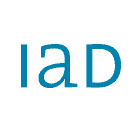Introduction
The measurement of psychophysiological parameters provides information on the psychological stress of the user, particularly on the basis of indicators of muscle activity (EMG), heart activity (heart rate, heart beat variability), electrodermal activity (skin conductance) or central nervous excitation (blood pressure):
Electromyography (EMG)
Technology
Electromyography (EMG) is a technique dedicated to the generation, recording and analysis of myoelectric signals. Myoelectric signals are generated by physiological variations in the state of the muscle fiber membrane due to action potentials. The focus of EMG assessments is on recording and analyzing voluntary muscle activation in functional movements and postural activities.
The IAD uses the latest Noraxon Ultium EMG measurement system with a measurement frequency of up to 4000 Hz – the gold standard for surface EMG measurement systems. The myoelectric signals are recorded wirelessly using surface electrodes, which are applied locally to the muscles to be examined. The application by the IAD is carried out according to strict scientific criteria, e.g. set by the SENIAM project. The data from the Ultium EMG has a low background noise and a high resistance to measurement artifacts.
Application
EMG as an analysis of muscular activity is primarily used for stress analyses during physical work or in ergonomic product design. However, increased activity of “resting” muscles can also be detected during emotional or informational arousal. However, EMG alone is difficult to interpret for informational activities.
Heart Rate
Technology
Electrocardiography (ECG) is the most reliable and most frequently used method in occupational science to determine the heart rate and the measured variables derived from it.
The recording of the heart rate is usually carried out by means of a Varioport device via three measuring electrodes or alternatively by means of a chest strap from Polar, which is worn underneath the chest. These systems measure the heart rate or R-pulses, which are emitted through the skin, via the skin electrodes. In order to keep skin resistance low, the skin area must be prepared by a local shave.
Application
As an integrating stress measure, HSF reacts to a variety of physical and predominantly non-physical stresses. While the HSF is constant at low physical stress levels, it shows a continuous increase at stress levels. The heart rate increases significantly under informational stress, such as information intake or decision-making processes, if this effect is not masked by energetic components (e.g. physical activity). The heartbeat variability derived from the heartbeat frequency and the frequency band analysis are further indicators for occurring mental stress. If the heart beat variability decreases while the heart beat rate is relatively low, it can be assumed that the user's workload increases. To analyze heart beat variability, a minimum recording rate of 500 Hz is required, which is only achieved with the Varioport system. The analysis of the heartbeat variability is performed by the Kubios HRV Premium software.
Skin conductance
Technology
Two electrodes are attached to the skin at a certain distance and the electrical resistance is measured. From the level and duration of the stimulus response, conclusions can be drawn about the psychological activity and the timing and intensity of an emotion experienced. A Varioport system from Becker Meditec is used for the measurement.
Application
Skin conductance determination is used for the objective, continuous or successive recording of skin conductance as a measure for psychological processes. If sweat is produced, e.g. during emotional stress, the skin's ability to act as an electrical conductor increases and so does the skin conductance value. It is therefore well suited to draw conclusions about this as well as about psychological activity.
Blood pressure
Technology
The arterial pressure is measured with the indirect method according to RIVA-ROCCI. The measurement is generally taken on the upper arm of the test person. The measuring device consists of an inflatable rubber cuff with an inextensible fabric support on its outside. With the help of a rubber balloon as pump and a needle valve, pressure changes can be made in the cuff and read off on a mercury or membrane manometer connected on the side.
Application
In addition to the measurement of the heart rate or the long-term ECG, blood pressure measurement is a non-invasive method for stress objectification. Blood pressure is recorded both at work and away from work using 24-hour blood pressure monitoring. In addition to the assessment of blood pressure variability, this allows statements to be made on the effects of workload on leisure time and sleep, as well as a comparison of total daily stress on a working day and a non-working day.







